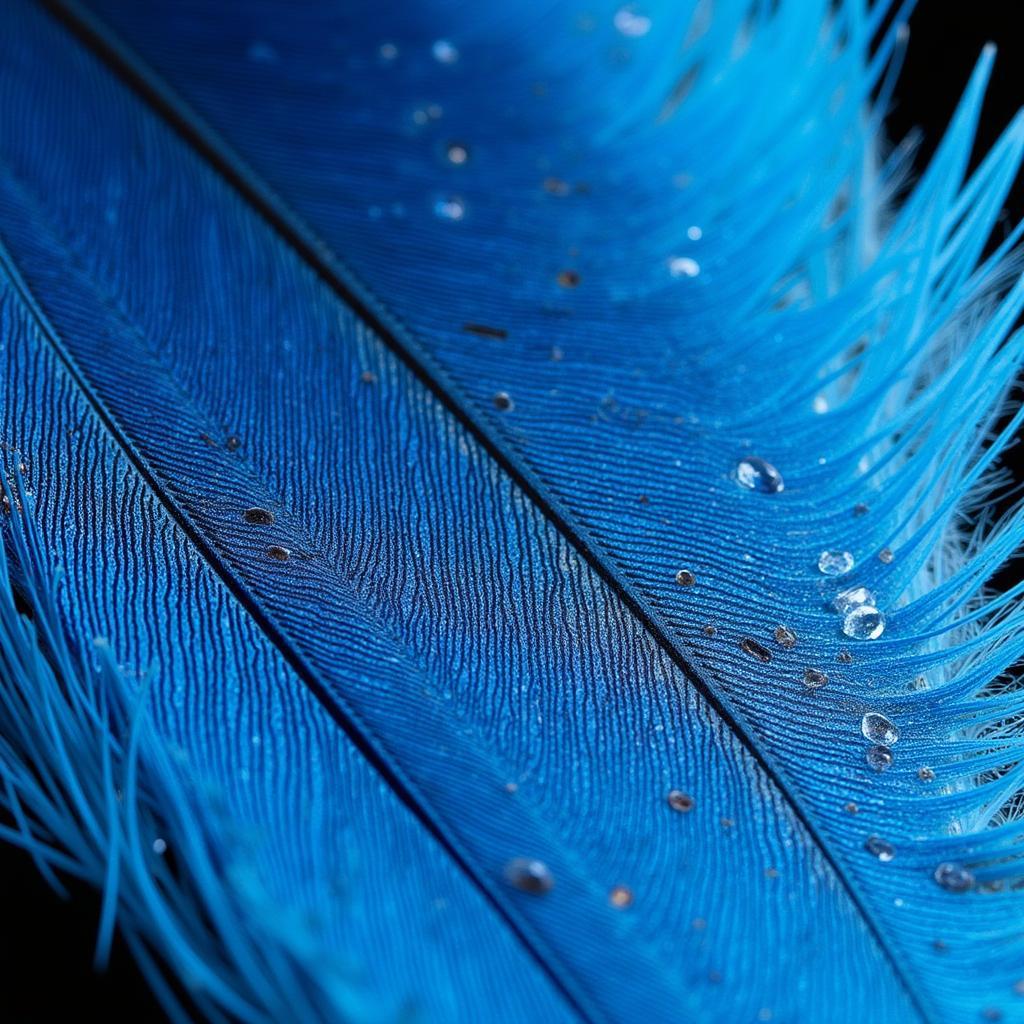Blue birds are a captivating sight, their vibrant plumage a splash of color against the natural world. But which birds exactly boast this beautiful hue? This article explores the diverse world of blue birds, from the familiar bluebird to more exotic species, discussing their habitats, behaviors, and the fascinating reasons behind their coloration.
Decoding the Blue: Why Are Some Birds Blue?
Unlike pigments like melanin that create browns and blacks, blue in birds isn’t due to a blue pigment. Instead, it’s a structural color created by the way light interacts with tiny air pockets within the feather barbs. This phenomenon, known as light scattering, causes blue wavelengths to be reflected while other colors are absorbed. The specific shade of blue depends on the size and arrangement of these air pockets. Similarly to how what colors attract bluebirds, the specific shade of blue is often related to mating rituals.
 Blue Bird Feather Structure Microscopic View
Blue Bird Feather Structure Microscopic View
Common Blue Birds Found Around the World
Several bird species are known for their blue coloration, and they can be found across various habitats. Some of the most common include:
- Eastern Bluebird (Sialia sialis): A familiar sight across eastern North America, the male Eastern Bluebird is a striking vision with its bright blue back and rusty red breast.
- Western Bluebird (Sialia mexicana): Found in western North America, this species sports a similar blue hue, often with a rusty or chestnut patch on its back.
- Mountain Bluebird (Sialia currucoides): As the name suggests, this bluebird prefers higher elevations in western North America. The male is a stunning turquoise blue, while the female has a more subtle blue-gray coloration.
Beyond the Bluebirds: Other Avian Species with Blue Hues
Blue isn’t exclusive to bluebirds. Many other bird species showcase varying shades of blue, often combined with other colors to create intricate patterns.
- Blue Jay (Cyanocitta cristata): A common bird in eastern North America, the Blue Jay boasts a vibrant crest, black markings, and a mix of blue, white, and black feathers.
- Indigo Bunting (Passerina cyanea): This small bird is a true spectacle during breeding season, with the male displaying a deep indigo blue.
- Steller’s Jay (Cyanocitta stelleri): Found in western North America, Steller’s Jay is known for its striking deep blue and black plumage and prominent head crest.
Where Can You Spot Blue Birds?
The best place to spot blue birds varies depending on the species. Understanding their preferred habitat is key. Do birds poop on certain color cars? While it might seem like a strange question, the color of a car could, theoretically, influence where birds choose to perch and therefore, where they might leave their droppings. Learn more about this fascinating topic at do birds poop on certain color cars. Bluebirds, for example, often prefer open woodlands, fields, and gardens. Providing nesting boxes can also encourage them to settle in your backyard.
The Role of Blue in Bird Behavior
The brilliant blue plumage of many birds plays a crucial role in their behavior, particularly in mating rituals and territorial displays. The brightness of the blue often signifies a bird’s health and fitness, making it an attractive feature for potential mates. This is similar to how what colors are hummingbirds attracted to, as specific colors attract hummingbirds for different reasons, like feeding or mating.
“The vibrancy of a bird’s blue plumage often indicates its overall health,” explains Dr. Avian Blue, an ornithologist specializing in bird coloration. “This makes it a critical factor in attracting mates and establishing dominance.”
Conservation Efforts for Blue Bird Species
While some blue bird species are thriving, others face threats due to habitat loss and other environmental factors. Conservation efforts are crucial to ensure their survival for future generations.
“Protecting the habitats of these beautiful creatures is essential for maintaining biodiversity,” adds Dr. Blue. “Simple actions like creating bird-friendly gardens and supporting conservation organizations can make a significant difference.” The question of what color is my energy is often a question asked by those who want to understand themselves better. Check out our article on what color is my energy. While the human psyche is fascinating, understanding the role of color in the natural world is also crucial.
Conclusion
From the familiar Eastern Bluebird to the striking Steller’s Jay, blue birds add a splash of vibrant color to our world. Understanding the science behind their coloration, their diverse habitats, and the role blue plays in their behavior enhances our appreciation for these fascinating creatures. By supporting conservation efforts, we can ensure that these beautiful birds continue to grace our skies for generations to come. Just as we are fascinated by the color changing properties of turkeys as seen in do turkeys heads change color, we should be equally interested in the vibrant blue hues of these other beautiful birds.
FAQ
- What causes the blue color in birds?
- What are some common types of blue birds?
- Where can I find blue birds?
- What role does blue play in bird behavior?
- How can I help protect blue bird populations?
- Are all blue birds the same shade of blue?
- Do female blue birds have the same coloration as males?
For further assistance, please contact us at Phone Number: 0373298888, Email: [email protected] Or visit our address: 86 Cau Giay, Hanoi. We have a 24/7 customer service team.

